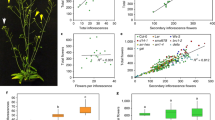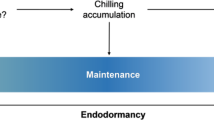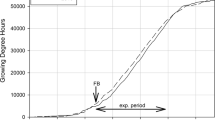Abstract
IN south-east England vegetative growth in the blackcurrant starts in April and ceases in July or early August, by which time shoots are about 60 cm long, bearing from twenty to thirty buds which usually start to initiate flowers from late June onwards. Normally, they do not break until the following spring.
This is a preview of subscription content, access via your institution
Access options
Subscribe to this journal
Receive 51 print issues and online access
$199.00 per year
only $3.90 per issue
Buy this article
- Purchase on Springer Link
- Instant access to full article PDF
Prices may be subject to local taxes which are calculated during checkout
Similar content being viewed by others
References
Thomas, G. G., and Wilkinson, E. H., Hort. Res., 4, 2 (1964).
El-Antably, H. M. M., thesis, Univ. Wales (1965).
Thomas, G. G., and Wilkinson, E. H., Proc. Sixteenth Intern. Hort. Congr. Brussels, 1962, 1 (1962).
Nasr, T., and Wareing, P. F., J. Hort. Sci., 36, 1 (1961).
Author information
Authors and Affiliations
Rights and permissions
About this article
Cite this article
COZENS, I., WILKINSON, E. Control of Lateral Bud Inhibition, Flower Emergence and Dormancy in the Blackcurrant. Nature 211, 867–868 (1966). https://doi.org/10.1038/211867a0
Issue Date:
DOI: https://doi.org/10.1038/211867a0
This article is cited by
-
Lateral bud outgrowth and its control by the apex
The Botanical Review (1976)
Comments
By submitting a comment you agree to abide by our Terms and Community Guidelines. If you find something abusive or that does not comply with our terms or guidelines please flag it as inappropriate.



